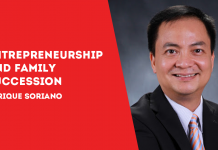
BY PROF. ENRIQUE SORIANO
WITH the likely collapse of many big businesses and corporate giants initiating restructuring programs as a result of the severe economic impact of the pandemic, there now exists a unique opportunity for family-run and managed businesses to show the world they possess the key to sustainability.
However, like a sword of Damocles hanging over every founder that is unwilling to transition properly, every family enterprise needs to get over the “succession curse” to which they cannot extend their legacy beyond three generations.
A recent example concerned a business that was started by a bank executive who availed himself of early retirement.
Frank (not his real name) was in his late 40s when he became an entrepreneur. All throughout his banking career, he established a solid relationship with most of his high net worth clients.
After pitching his brilliant idea to some of his investor-friends, one loyal client ended up becoming his industrial partner. After a decade of spectacular growth, he acquired full control of the business, effectively buying out his partner.
No doubt, Frank was extremely talented. He plowed back his earnings by investing heavily on top-of-the-line machines that efficiently produced household materials translating to higher margins than his competitors. On top of his cost structure model, clients loved him for his personalized service too.
With better margins, Frank expanded and diversified into other businesses. The growth trajectory continued for several more years.
His children also worked with him, but he never took them into his confidence, their careers were not planned and they were never trained or allowed to take on serious responsibilities. Nevertheless, Frank was enthusiastic about the prospect of leaving a legacy by passing the business on to them, and over many dinners, spoke about succession and stewardship and his desire to retire.
Unfortunately, he made no plans for the transition. It was all talk but no action. In his 60s and still very much in control, he unexpectedly died following a heart attack at age 64.
The future of his booming businesses that grew to several thousand employees was thrown into chaos because he left no will and there was no clear succession plan.
Frank had almost single-handedly steered the group since its creation, building products after products and dominating competition, alongside diversified interests from real estate development to food. However, his untimely death damaged confidence and blemished his business holdings.
It also ushered in a lengthy period of recovery as creditors started to pressure the businesses he left behind. The next generation offspring felt totally unprepared to take over. Despite working at the firm for more than a decade they had no experience managing the company at that level, nor did they have a clear picture of how the business worked. The firm and the other businesses were eventually sold.
In many cases, the alternatives are usually bleak. Succession is an organized and gradual process and three transitions usually happen in parallel but in different phases. These are:
a. next generation transition and ownership, then
b. change of the Owner-Manager to Owner, and finally
c. move from being an “all family” affair to a non-family management team
This process does not always happen at the same time. It is a transition where the founder willingly allows family members to join him in managing the business but resisting the part where he has to share power and control.
Succession can be a tension filled period of the family business where a trained successor grows into the role under the owner’s supervision and guidance or it takes place abruptly and unexpectedly when the owner becomes ill or dies, in which case unprepared family members suddenly find the job forced upon them.
The death of Frank triggered the beginning of the end of the family business. As one colleague recounted, “It was chaotic for the family, employees and the business itself but one that was completely avoidable.”/PN





